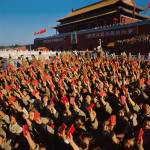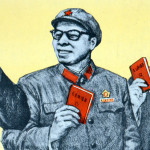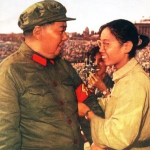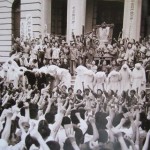
The Cultural Revolution was driven by the Red Guards, a mass movement encouraged and directed by Mao Zedong. They became Mao’s power base as he reinstalled himself as leader of both party and nation while purging the party of his critics and competitors. Comprised mostly of fanatical students, the Red Guards (Hongweibing) began to take shape in June 1966, following the national publication of a student protest in Beijing University. Within weeks they had mobilised into a political militia, their numbers exceeding 10 million. Motivated by Mao’s slogans “It is right to rebel” and “Bombard the headquarters”, the Red Guards attacked anyone and anything they considered a threat to Mao or his socialist vision. Nobody was safe: not bureaucrats or administrators, not party chiefs, not provincial politicians, not even president Liu Shaoqi. For a year these militant students created what Mao himself called a “great chaos under heaven”. When the Red Guards became even more radical and violent in 1967, it was Mao himself who authorised military action to suppress them.
The origins of the Red Guards can be traced to Beijing University. In the spring of 1966, Mao’s Cultural Revolution was still only an academic debate, confined mainly to the universities. This began to change after the Chinese Communist Party (CCP) Central Committee released its May 16th circular, calling for a purge of the “bourgeoisie who have sneaked into the party, the government and various sphere of culture”. On May 25th Nie Yuanzi, a 45-year-old philosophy lecturer, put up a dazibao (‘big character poster’) critical of the university’s administration. Motivated as much by personal grudges as politics, Nie’s poster accused the university’s leaders of harbouring anti-socialist bourgeois ideas, and denying the students’ right to protest and revolt. “Now the people of the whole country, in their great love of the party and of Chairman Mao, and their extreme hatred for anti-socialists, have risen up in a cultural revolution”, she wrote, “but the administration [of the university] is as not moved. The campus is quiet”. Nie’s protest captured the attention of Mao. Within a week he had the text of her poster published in state newspapers and read aloud on government radio.

This publicity, which implied endorsement from Mao, triggered the birth of the Red Guards. The first Red Guard organisation was mobilised on May 29th, by middle schoolers attached to Qinghua University. Students at various middle schools and colleges around Beijing began to follow suit. Through June and July, these militant students held meetings, formed associations and adopted names like “Red Flag Combat Team” and slogans like “Safeguard Mao Zedong”. Behind the scenes, Mao was encouraging this burgeoning movement. At the start of June, Mao had his secretary Chen Boda take control of the People’s Daily and publish an editorial titled “Sweep away all the Monsters and Ghosts”. Some interpret this as Mao’s public unfurling as the Cultural Revolution. State newspapers and radio continued to fuel the movement by repeating dazibao posters and the speeches of Red Guard leaders. By late July the schools, colleges and urban streets of China boasted thousands of different Red Guard brigades, with membership in the millions. Their brigades were developed locally and without centralised control, so there was some variation in how they were organised and what they did – but they all served a common purpose: loyalty to Mao and an unflinching commitment to his ideas.

As popular as the movement was, it was yet to receive the direct endorsement of Mao. This came on August 1st when the Chairman answered letters from the Red Guards from Qinghua. In his return letter, Mao offered a ringing endorsement and his “enthusiastic support” to the Red Guards. News of this spread quickly and created another surge in the movement. On August 18th, Mao appeared in person before a rally of around one million Red Guards in Tiananmen Square. The Chairman offered his support to the movement by replicating their olive green uniform, then accepting and wearing the armband favoured by the Red Guards. Mao also stood for several hours while Lin Biao and Red Guards leaders addressed the throng. Over the next three months, Mao would appear before an estimated 13 million Red Guards at eight different rallies in Tiananmen. By early November 1966, the numbers attending these rallies had swelled to two million; the last of the eight rallies (November 25th) saw an estimated 2.5 million Red Guards in attendance.

What began as student groups to debate bourgeois ideas in culture had become a nationwide movement demanding cleansing, rethinking and transformation. The Red Guards combined Mao’s socialist idealism with political fanaticism and the militancy, iconoclasm and anti-authoritarianism of young students. At the August 18th rally Mao and Lin Biao urged the students to “Destroy the Four Olds”: old ideas, old culture, old customs and old habits. The Red Guards took up challenge task with zeal. By late August they were rampaging through Beijing and other cities, lining the streets with dazibao, distributing pamphlets, staging rallies and delivering impromptu political speeches. They rooted out and destroyed anything associated with China’s imperial history. Signs and street names were torn down or renamed. Architecture, art, antiques, sculpture and works of literature were all torn apart or burnt, and those who possessed them were arbitrarily punished. Historical landmarks, temples and palaces were destroyed or vandalised. Even the Forbidden City almost fell victim to the Red Guards, saved only for the quick thinking of Zhou Enlai, who ordered it to be secured.

The Red Guards also targeted people. Intellectuals and former capitalists were intimidated and physically attacked. So too were Chinese in foreign clothing, even Catholic nuns. Private homes were raided, residents beaten and vast amounts of private property seized. According to historian Ma Yuping, the ‘Demolish the Four Olds’ campaign saw more than 48 billion yuan in private property seized and surrendered to the state. Hundreds of thousands of people lost their homes, their life savings and precious family heirlooms. By the autumn of 1966, they were confident enough to target municipal and provincial governments and high profile political figures. The students were further encouraged by Mao Zedong’s famous August 5th poster urging the Red Guards to “Bombard the Headquarters!” In this dazibao, also widely published by the state press, Mao accused the government of the People’s Republic of having become a “bourgeois dictatorship… They have stood facts on their head and juggled black and white, encircled and suppressed revolutionaries, stifled opinions differing from their own, imposed a white terror, and felt very pleased with themselves. They have puffed up the arrogance of the bourgeoisie and deflated the morale of the proletariat. How poisonous!”
“Many have sought to explain the features of the Red Guard movement by referring to the character of social and political institutions of the Mao-era. Some claim that the intense political indoctrination of China’s youth into the cult of Mao and the doctrines of class struggle created dogmatic mentalities of unquestioning loyalty, that fuelled the violence and intolerance of mobilised students. Others argue that the Chinese political system enclosed citizens in social institutions where they were closely monitored, politically labelled in ways that affected their welfare and futures, and periodically subjected to stressful mass campaigns that left aggrieved victims in their wake – circumstances that contributed to the subsequent tumult.”
Andrew G. Walder, historian
Attacks on prominent party figures accelerated in the last two months of 1966. Among those subject to public vitriol and humiliation were national president Liu Shaoqi, his moderate ally Deng Xiaoping and former Five Man Group spokesman Peng Zhen. Liu was the most harshly criticised, denounced as the “biggest capitalist-roader in the party” for his economic policies and his refusal to fully support the Cultural Revolution. Former defence chief Peng Dehuai, purged in 1959 for criticising Mao, was arrested, beaten and subjected to several public ‘struggle sessions’. In January 1967 Liu Shaoqi and his wife Wang Guangmei were attacked in their home by trespassing students. Two of Liu’s own children were convinced to denounce him, after pressure from local Red Guards and Jiang Qing herself. In March 1967 the CCP Central Committee, under pressure from Mao and the Red Guards, formed a subcommittee to investigate allegations about Liu Shaoqi and his alleged treachery against the socialist line.

1. The Red Guards were paramilitary style organisations, formed in mid-1966 by militant students who were fanatically loyal to Mao Zedong.
2. The Red Guards movement began with Mao’s call to identify and deal with capitalist and bourgeois ideas in schools and universities, a challenge first accepted by radical students in Beijing.
3. Red Guard numbers grew quickly, encouraged in no small part by publicity and propaganda disseminated by the state press, as well as endorsement and encouragement from Mao himself.
4. Mao called on the Red Guards to “bombard the headquarters” (attack reactionary figures in the party and government) and “demolish the Four Olds” (old ideas, customs, culture and traditions).
5. By late 1966 the Red Guards had escalated their attacks, destroying symbols of the old order, seizing millions of yuan in private property and arresting and persecuting leaders such as Peng Dehuai, Peng Zhen and Deng Xiaoping.

A Red Guard rebels against her teacher (1966)
A Chinese editorial on the Red Guards (August 1966)
The Red Guards are a ‘shock force’ (September 1966)
Battle song of the Red Guards (1967)
A teenage girl denounces her parents (1968)
A CIA report on the role of the Red Guards (November 1968)
China Pictorial: “The whole family is Red” (May 1969)
Mao Zedong and Lin Biao criticise Red Guards leaders (1968)
© Alpha History 2018. Content on this page may not be republished or distributed without permission. For more information please refer to our Terms of Use.
This page was written by Glenn Kucha and Jennifer Llewellyn. To reference this page, use the following citation:
G. Kucha & J. Llewellyn, “The Red Guards”, Alpha History, accessed [today’s date], https://alphahistory.com/chineserevolution/red-guards/.
This website uses pinyin romanisations of Chinese words and names. Please refer to this page for more information.
